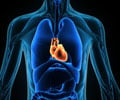Groundbreaking ultrasound techniques that grant the first characterization of multidirectional blood flow in the heart by Researchers from Mount Sinai School of Medicine.

The ultrasound tools cardiologists use today often fail to detect changes in the heart until there is overt dysfunction. Blood flow imaging, however, may provide better clues in diagnosing heart failure. Sinai investigators reason that flow should be immediately affected by changes in cardiac function – such as those revealed in image analysis by the chaotic behavior of tiny whirlpools.
The computer-aided visual study of these abnormalities could dramatically improve the assessment of patients with heart failure and lead to a fresh understanding of normal and abnormal pumping and circulatory function. Visual blood-flow analysis could also yield improved therapies for arrhythmias and other disorders requiring cardiac synchronization. Researchers are actively exploring applications in aortic atherosclerosis, before and after valve replacement, and congenital abnormalities.
"With visualization, we are looking at the ultimate measure of the efficiency of the heart – how the blood is brought in and how it is sent out," said Jagat Narula, MD, PhD, Director of Cardiovascular Imaging at Mount Sinai and the senior author of the paper. "Today, cardiologists place great weight on a gauge called the squeeze fraction, or ejection fraction – the portion of blood pumped from the ventricle with each heartbeat. What we are doing is a complete departure from the view of the heart as a squeezing, pressure-generating chamber."
Mount Sinai researchers and their collaborators have experimented with a range of imaging techniques to grasp the characteristics of normal and abnormal blood flow. The approaches include phase-encoded MRI, cardiac magnetic resonance (CMR) and several forms of ultrasound-based imaging known as echocardiographic particle imaging velocimetry.
"The most effective technique involves injecting a stream of bubbles that behave exactly like red blood cells and using echocardiography to track their path through the left ventricle," said Partho Sengupta, MD, Director of Cardiac Ultrasound Research at Mount Sinai, and the first author, with Narula, of the JACC paper. In these investigations, the computer-enhanced video output depicts normal and turbulent flow in vivid detail, with arrows plotting the direction as the bubbles swirl through the heart chamber.
Advertisement
The echocardiography technology pioneered by Sengupta and Narula sheds light on diagnostic discrepancies that have puzzled cardiologists relying on pressure measurements.
Advertisement
Diagnosing cardiac disease by looking for structural defects in the heart is like analyzing highway traffic by examining the road, Dr. Narula said. "The structure may not be great, but how does that affect the cars that are actually traveling on the road? It's the same thing if you fail to look at the blood."
Likewise, a plumber's investigation of pipes in a house only matters or makes sense in relation to how the water flows, claims Sengupta. A new study these investigators have submitted for publication zeros in on specific correlations between blood flow and cardiac pathology. "We will be able to demonstrate that efficiency may be lost even though the structure is maintained," said Senguptra. "In other words, the façade is good, but inside, you have lost it."
Sengupta points out that the combined visualization and computation techniques in the JACC paper are still new and require further work, including development of appropriate flow-based indexes for applications in various cardiac pathologies. Forces acting on flow are exceedingly complex and dynamic, the researchers said. Pumped by the heart at a rate of 8 pints to 16 pints per minute, blood interacts with the contours of the myocardium, valves, vessels, and other features, which are also in motion. The flow is multidirectional – curling, spinning, and forming eddies that are affected in countless ways by structural changes in heart tissue. As with any new observational techniques, data from novel cardiac visualizations in complex environments are subject to interpretation.
"We have started using these imaging techniques in clinical trials," Narula said. "They will require careful evaluation."
Source-Eurekalert














